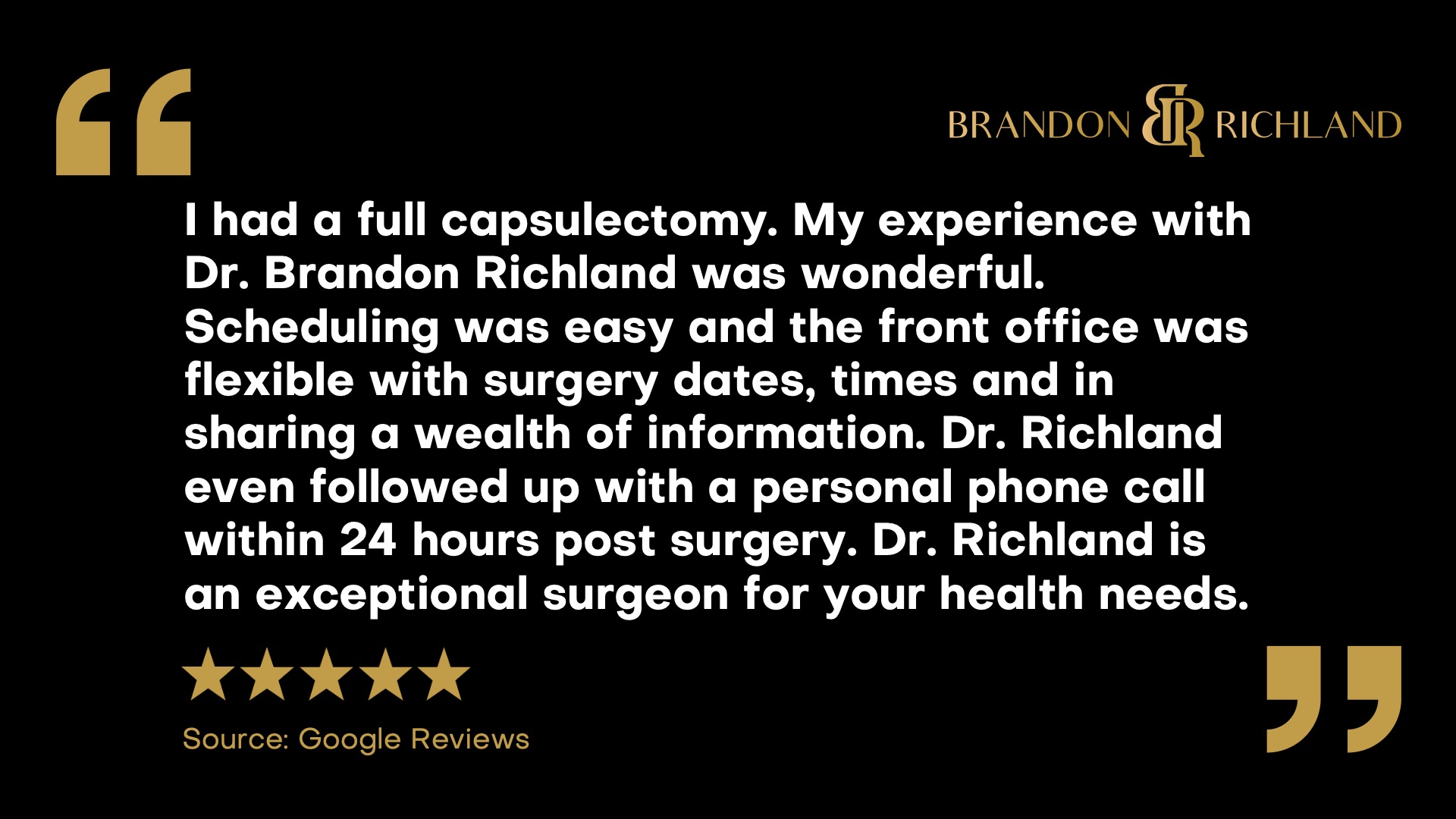Published by Dr. Brandon Richland, MD

“I had a full capsulectomy. My experience with Dr. Brandon Richland was wonderful. Scheduling was easy and the front office was flexible with surgery dates, times and in sharing a wealth of information. Dr. Richland even followed up with a personal phone call within 24 hours post surgery. Dr. Richland is an exceptional surgeon for your health needs.”
Read the full Google Review here.
Understanding Capsulectomy
Capsulectomy is a surgical procedure often associated with breast implant corrections. The section below outlines its definition, reasons for surgery, and the various surgical approaches.
What Is Capsulectomy?
Capsulectomy is the surgical removal of the capsule, which is the scar tissue that naturally forms around a breast implant. Over time, this scar tissue can sometimes become thick and hard, a condition known as capsular contracture, which may necessitate this procedure.
Indications for the Procedure
The primary indication for a capsulectomy is the development of capsular contracture, an abnormal response where the capsule compresses the implant, causing discomfort, pain, and aesthetic concerns. Other indications include:
- Breast Implant Illness (BII): Some patients choose to undergo capsulectomy due to perceived symptoms of BII, such as fatigue and joint pain, thought to be related to their implants.
- BIA-ALCL: Patients with a rare type of lymphoma called Breast Implant-Associated Anaplastic Large Cell Lymphoma may require capsulectomy.
- Implant Rupture: If an implant breaks, a capsulectomy may be needed to remove the capsule and the leaked material.
Types of Capsulectomy
There are different types of capsulectomy procedures:
- Total Capsulectomy: The entire capsule is removed without violating its structure.
- Partial Capsulectomy: Only a section of the capsule is removed.
- En Bloc Capsulectomy: Removal of the implant and the entire capsule as one unit, without opening or disturbing the capsule; often preferred when BIA-ALCL is a concern.
This surgical procedure might be performed in conjunction with a capsulotomy, which is the surgical release of the capsule, and can be done through an open capsulotomy (cutting the capsule) or a less invasive closed capsulotomy(breaking the capsule without incisions).
The Surgical Process
The surgical process of capsulectomy involves meticulous planning, precise technique, and comprehensive postoperative care to ensure the best outcomes for patients.
Pre-Surgical Considerations
Before proceeding with a capsulectomy, it is essential that the patient undergoes a thorough evaluation to plan the surgery effectively. This includes:
- Medical Assessment: Assessing the patient’s general health to ensure they are fit for surgery and anesthesia.
- Imaging: Using imaging studies like MRI or ultrasound to visualize the extent of scar tissue formation.
- Discussion of risks: Informing the patient about potential complications such as infection, bleeding, hematoma, or seroma.
- Implant Considerations: Considering whether an implant removal or replacement is part of the procedure.
Capsulectomy Techniques
During the actual surgery, the surgeon will:
- Administer Anesthesia: Ensure the patient is comfortable and pain-free.
- Make an Incision: Choose an incision location that minimizes scar visibility.
- Remove Scar Tissue: Carefully excise the scar tissue or capsule that has formed around the implant.
- Handle the Implant: If involved, remove or replace the breast implant.
The goal is to address any complications like implant extrusion while minimizing the risk of recurrence.
Postoperative Recovery
The recovery phase is crucial for achieving the desired result:
- Drains: Small tubes may be placed to drain excess fluid and reduce the risk of seroma or hematoma.
- Sutures: The incisions are closed with sutures, which may be absorbable or may need removal.
- Care Instructions: Patients receive detailed instructions on incision care to minimize the risk of infection and swelling.
- Activity Restrictions: A gradual return to activities is advised, with an emphasis on avoiding strain on the chest area to promote healing.
Potential Risks and Complications
Capsulectomy surgery, while effective, carries the inherent risk of complications, as do all surgical procedures. Patients should be well-informed about the potential risks and the importance of vigilant post-operative care to manage any adverse outcomes effectively.
Recognizing Complications
Complications from capsulectomy can arise at various stages post-surgery. Key issues to be aware of include:
- Capsular Contracture: A condition where the scar tissue around an implant tightens, causing discomfort or changes in breast appearance.
- Infection: Highlighted by symptoms such as redness, swelling, and sometimes fever, which may occur if bacteria contaminate the site during or after surgery.
- BIA-ALCL: A rare type of lymphoma associated with breast implants that presents as swelling or pain around the breasts.
- Rupture: The breach of an implant shell can lead to leakage of its contents, which may cause an inflammatory response.
- Breast Implant Illness (BII): A term used to describe a wide range of symptoms, including fatigue, breast pain, and cognitive issues, potentially related to implants.
Patients noticing unusual symptoms such as persistent pain, redness, swelling, or bruising should contact their healthcare provider to discuss possible complications.
Managing Adverse Outcomes
Effective management of complications is essential to minimize long-term consequences:
- Follow-up Care: Regular monitoring post-surgery helps to detect early signs of complications such as infections or breast pain.
- Immediate Attention: Prompt treatment of infection with antibiotics or additional surgery if necessary.
- Monitoring for Cancer: Ongoing screening for BIA-ALCL, particularly if symptoms like persistent swelling present.
- Risk of Recurrence: In some cases, capsular contracture can recur, requiring careful management to prevent subsequent issues.
Supporting measures like a clean surgical environment, appropriate antibiotic use, and ensuring the surgical team is aware of any prior surgical history involving bacteria or biofilm are important in managing the risk. If complications arise, a comprehensive treatment plan tailored to the individual can mitigate adverse outcomes.
Schedule Your First-Class Cosmetic Consultation with Dr. Brandon Richland, MD
Contact Dr. Richland today by visiting RichlandMD.com, scheduling a cosmetic consultation, or by calling 714-844-0398 or 949-997-2958 directly.










